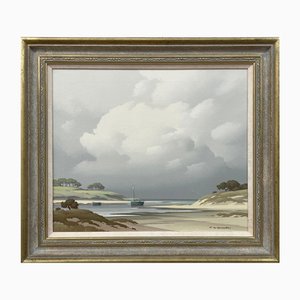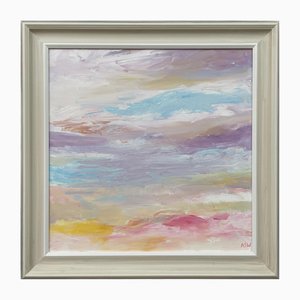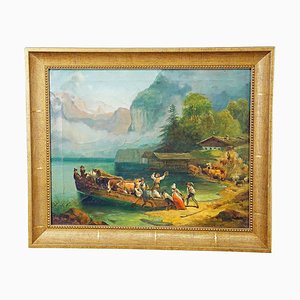Style : French school XXth century
Condition : Excellent
Technique : Oil on canvas
Other : Signed lower right and dated 1906.
Height : 45 cm
Width : 55 cm
Dimensions with the frame: 62 cm/ 71 cm
Here is an interesting work by its pointillist character and its year of execution (1906) ... We were not able to locate the place but it is perhaps the Canal du Loing which was also frequented by the friend of the painter Alfred Sisley... No certainty however.
This luminous work, shows all the talent of this artist who was hermetic to the great mediatization, what left him far from the big demonstrations and explains certainly his relative anonymity... He remains an excellent painter who could have joined the Pantheon of the impressionists...
Antony Damien
1858 - 1943
Painter
Self-taught, Antony Damien is a friend of Alfred Sisley and Jean-François Raffaelli whom he considers as his masters. Sensitive to changes in light and weather phenomena, he painted many landscapes of Paris and its surroundings, but also in the provinces.
He exhibited at the Salon des artistes français in 1890 Vieux hêtres and Forêt de Fontainebleau, and at the Salon de la Société nationale des beaux-arts in 1921 Maison à travers les arbres and in 1922 Neige.
Unlike his friend Sisley who ended his life in poverty, Antony Damien was never in need.
Antony Damien married Julie Gano in a first marriage, to which the painter Antoine Guillemet was witness. He married Marie Pironnet, a student of Vincent d'Indy and professor of singing at the Schola Cantorum, in 1919.
He is the half-brother of the playwright Eugène Damien (1846-1902) and the uncle of Gustave Damien, actor and director of theatrical tours.
His mother Louise Alphonsine Hubert married in 1885 Jacques Alexandre Robert Dumesnil, Notary, the son of Alexandre-Pierre-François Robert-Dumenil, also a notary and a print lover and French art historian, known for his book Le peintre-graveur français ou Catalogue raisonné des estampes gravées par les peintres et les dessinateurs de l'École française (1938), which is a sequel to Adam von Bartsch's Peintre-graveur, but concerning French printmakers.
Antony Damien is a researcher, his work is uneven but sincere. His age will not stop his evolution. His palette, as he grew older, took on more muted tones.
In 1939, a congestion will affect his vision of colors. Nevertheless, he started to paint again, sometimes finding, despite the grey echoes of the war, a semblance of good humor. A few weeks before his death, still seeking to renew himself, he sketched a last canvas.
"Antony Damien was an original, a pure independent who feared praise, criticism and merchants, a man of character - and everyone knows that men of character generally have it bad.
This is an unusual destiny for this work which, during the sixty years of its creation," wrote his biographer Jacques Saisset in 1947, "passed silently but without fail from the easel where it was born to the walls of bourgeois homes.
Damien is not included in any museum; only the Fontainbleau town hall has preserved La Celle-sur-Seine, one of the landscapes that was auctioned off in that city on August 8, 1943. Cheerful and Rabelaisian, noisy, athletic, getting up at 5 o'clock every morning to go on the motif, he took pleasure in discouraging his possible amateurs ("My painting pleases you, what do you want it to do to me?"). An attitude that can explain the oblivion into which these works have fallen, all of light and reflections, of fine grays very lightly colored, supported by a drawing that is both firm and blurred, paintings that have the transparency and vibration of pastel: "Nature is blond," he said, "it must be painted with distinguished tones:
A landscape must be enveloped, to make dream".
He attenuated the brightness of the colors by absorbing preparations with the white of Meudon which "make pass the oil on the other side of the canvas".
Initially destined for a dramatic career, he then composed a few station posters and went to paint as a simple amateur, in the company of Sisley and Raffaëli, whom he always considered his masters; he also frequented Le Sidaner, whose influence he temporarily underwent.
Around 1892, he discovered Chateurenard and often returned to work there for over thirty years.
In 1899, he settled in La Celle-sur-Seine and then ten years later in Moret, renting the apartment in Fontainbleau where he would end his life.
In addition to landscapes of the Loiret and Normandy, he left city views, of Avignon for example and of Paris, where one can read different variations on his favorite places, the Bastille, the Boulevard Raspail and the Place Saint-André-des-Arts.




Get in Touch
Make An Offer
We noticed you are new to Pamono!
Please accept the Terms & Conditions and Privacy Policy
Get in Touch
Make An Offer
Almost There!
To follow your conversation on the platform, please complete the registration. To proceed with your offer on the platform, please complete the registration.Successful
Thanks for your inquiry, someone from our team will be in touch shortly
If you are a Design Professional, please apply here to get the benefits of the Pamono Trade Program